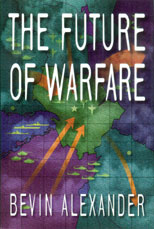The Future of Warfare
 Click here to purchase from Barnes & Noble.
Click here to purchase from Amazon.com.
Click here to purchase from Barnes & Noble.
Click here to purchase from Amazon.com.
The conflicts the United States will enter and the ways we will fight them have changed. Highly accurate weapons and great mobility have made it impossible for troops to survive on traditional battlefields. Every place now is vulnerable. The American military will concentrate on fast, lethal small forces. Our enemies’ only recourse is to strike from the shadows in guerrilla-type warfare.
- Introduction
- Lawrence of Arabia's Strategy
- Mao Zedong's Theories on Warfare
- Tactics of the Chinese Communists in the Korean War
- Military Doctrine of Vietnamese Leader Giap
- The United States Will Not Create an Empire
- Index
Introduction
Lord Keynes said, “The inevitable never happens. It is the unexpected always.” Even so, we can be sure that war will never again be like the great world wars of the twentieth century.
Chapter 1: American Strategy for the New Era
There is little danger that the United States will face a world power seeking to gain dominance in Eurasia. But aggression of other sorts will come, and the U.S. must be prepared to respond quickly. It must maintain its supreme navy and air force and build a fast, flexible army.
Chapter 2: What Kind of Wars Will We Fight?
No country will challenge America’s superior military technology. In the future we will primarily confront opponents armed with only basic weapons fighting mainly guerrilla wars.
Chapter 3: America Rules the Waves
The United States Navy is vital to our ability to confront any challenge on earth. We cannot rely on having land bases everywhere, but with our carrier task forces, plus our long-range bombers, we can reach any danger spot on earth.
Chapter 4: New Tactics for a New Army
The nation’s ground forces must be reorganized to respond quickly to small-scale challenges everywhere. The days of heavy divisions and long lines of resistance manned by millions of soldiers, as was the case in World War II and Korea, have passed.
Chapter 5: The Boer War: Prologue to the Future
The South African War 1899-1902 provided a model. The Boers, after losing an effort to fight a conventional war against the British, turned to guerrilla warfare and were successful.
Chapter 6: Converting Stalemate to Victory
Description of the methods a few thousand Boers used to immobilize a British army many times larger and with vastly superior weapons. A precursor to the American involvement in Vietnam.
Chapter 7: War against a Vapor
Description of the guerrilla methods Lawrence of Arabia used in World War I to neutralize much superior Turkish forces. He employed only the skills the Bedouin tribesmen already possessed.
Chapter 8: Mao Zedong: Strike Enemy Weakness
Description of the guerrilla-like army Mao Zedong created to counter the Nationalists in China in the late 1920s and 1930s. This army was based on the teachings of the ancient Chinese strategist Sun Tzu. It nullified vastly superior Nationalist strength and led to the victory of Communism in China.
Chapter 9: Korea: Challenging the Strong Head to Head
Description of the success that much more poorly armed Chinese forces had against Americans armed with top-of-the-line weapons. The Chinese reduced American strength by fighting in mountains and building massive bunkers to shield against American firepower.
Chapter 10: Giap: Neutralizing Military Power
Giap adopted the doctrines of Sun Tzu and Mao Zedong and created an invincible military system that defeated both the French and the Americans. Full description of the Vietnamese Communist methods.
Chapter 11: Why the Vietnam War Was a Mistake
Explaining how American commanders never understood that they could not succeed in a conventional war, using overwhelming firepower, against an enemy who refused to fight this kind of war, but who struck hard and fast at vulnerable targets and then disappeared into the jungles or into the population.
Chapter 12: Defeating the American Colossus
Careful examination of Communist Vietnamese battle tactics and strategy which neutralized American power.
Chapter 13: Winning or Avoiding Future Wars
America must work with other peaceful powers to resolve international issues. We must be the world’s honest broker. We cannot be the entire world’s protector. We should intervene primarily in places where our national interests are at stake. But we should remember Vietnam and choose invasion as the last resort.